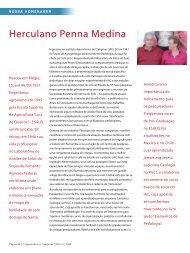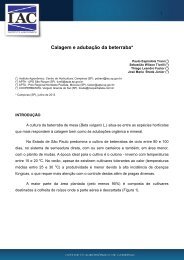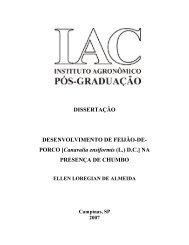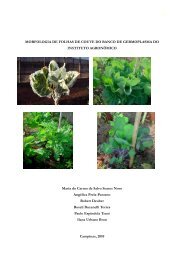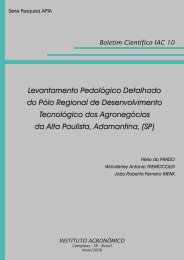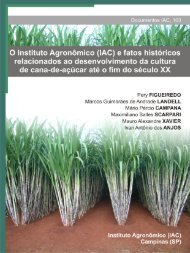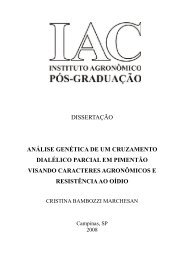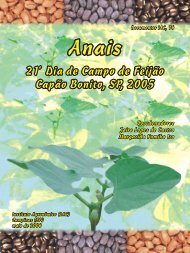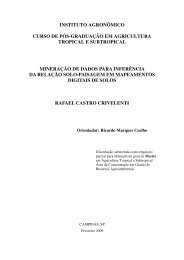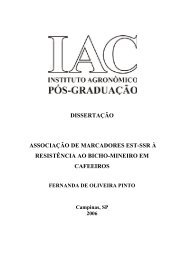Documentos IAC 84 - (ISSN 1809-7693) - Governo do Estado de ...
Documentos IAC 84 - (ISSN 1809-7693) - Governo do Estado de ...
Documentos IAC 84 - (ISSN 1809-7693) - Governo do Estado de ...
Create successful ePaper yourself
Turn your PDF publications into a flip-book with our unique Google optimized e-Paper software.
<strong>ISSN</strong> <strong>1809</strong>-<strong>7693</strong><br />
MELHORAMENTO GENÉTICO DE COFFEA ARABICA L.:<br />
Transferência <strong>de</strong> genes <strong>de</strong> resistência a Hemileia<br />
vastatrix <strong>do</strong> Híbri<strong>do</strong> <strong>de</strong> Timor para a cultivar<br />
Villa Sarchí <strong>de</strong> Coffea arabica<br />
Aníbal Jardim BETTENCOURT<br />
Luiz Carlos FAZUOLI<br />
<strong>Documentos</strong> <strong>IAC</strong>, Campinas, n. o <strong>84</strong>, 2008
Ficha elaborada pelo Núcleo <strong>de</strong> Informação e Documentação <strong>do</strong> Instituto Agronômico<br />
B465m C977a<br />
Bettencourt, Aníbal Jardim<br />
Melhoramento genético <strong>de</strong> Coffea arabica L.: transferência <strong>de</strong><br />
genes <strong>de</strong> resistência a Hemileia vastatrix <strong>do</strong> Híbri<strong>do</strong> <strong>de</strong> Timor para a<br />
cultivar Villa Sarchí <strong>de</strong> Coffea arabica / Aníbal Jardim Bettencourt;<br />
Luiz Carlos Fazuoli. Campinas: Instituto Agronômico, 2008.<br />
20p. (<strong>Documentos</strong> <strong>IAC</strong>, <strong>84</strong>)<br />
<strong>ISSN</strong>: <strong>1809</strong>-<strong>7693</strong><br />
Versão on-line<br />
1. Coffea arabica 2. Melhoramento genético I. Fazuoli, Luiz Carlos<br />
II. Série III. Título<br />
CDD 633.73<br />
A eventual citação <strong>de</strong> produtos e marcas comerciais, não expressa, necessariamente,<br />
recomendações <strong>do</strong> seu uso pela Instituição.<br />
É permitida a reprodução, <strong>de</strong>s<strong>de</strong> que citada a fonte. A reprodução total <strong>de</strong>pen<strong>de</strong> <strong>de</strong> anuência<br />
expressa <strong>do</strong> Instituto Agronômico.<br />
Comitê Editorial <strong>do</strong> <strong>IAC</strong><br />
Oliveiro Guerreiro Filho - Editor-Chefe<br />
Ricar<strong>do</strong> Marques Coelho<br />
Cecilia A. F. P. Maglio<br />
Equipe Participante <strong>de</strong>sta Publicação<br />
Coor<strong>de</strong>nação da Editoração: Marilza Ribeiro A. <strong>de</strong> Souza<br />
Revisão <strong>de</strong> Vernáculo: Maria Angela M. Silva<br />
Editoração eletrônica e Criação da Capa<br />
Instituto Agronômico<br />
Centro <strong>de</strong> Comunicação e Transferência <strong>do</strong> Conhecimento<br />
Avenida Barão <strong>de</strong> Itapura, 1.481<br />
13020-902 Campinas (SP) - BRASIL<br />
Tel: (19) 3231-5422 (PABX)<br />
Fax: (19) 3231-4943<br />
www.iac.sp.gov.br<br />
Tiragem: 500 exemplares (outubro <strong>de</strong> 2008)
Sumário<br />
Página<br />
RESUMO .................................................................................................................................... 1<br />
ABSTRACT................................................................................................................................. 2<br />
1. INTRODUÇÃO ............................................................................................................................ 2<br />
2. MATERIAL E MÉTODOS ............................................................................................................ 3<br />
2.1 Avaliação <strong>de</strong> reação à ferrugem .......................................................................................... 4<br />
3. RESULTADOS ............................................................................................................................ 4<br />
4. DISCUSSÃO E CONCLUSÕES ................................................................................................ 5<br />
AGRADECIMENTOS .................................................................................................................. 10<br />
REFERÊNCIAS .......................................................................................................................... 11
MELHORAMENTO GENÉTICO DE COFFEA ARABICA L.:<br />
Transferência <strong>de</strong> genes <strong>de</strong> resistência a Hemileia<br />
vastatrix <strong>do</strong> Híbri<strong>do</strong> <strong>de</strong> Timor para a cultivar<br />
Villa Sarchí <strong>de</strong> Coffea arabica<br />
Aníbal Jardim BETTENCOURT ( 1 )<br />
Luiz Carlos FAZUOLI ( 2 )<br />
RESUMO<br />
Progênies F 2 das plantas 1, 3 e 4 <strong>do</strong> híbri<strong>do</strong> CIFC H 361 (CIFC 971/10 Villa Sarchí x CIFC 832/2<br />
Híbri<strong>do</strong> <strong>de</strong> Timor) e populações <strong>de</strong> progênies F 3 , F 4 e F 5 <strong>de</strong>ssas plantas, em experimentos <strong>de</strong> campo<br />
no <strong>IAC</strong> (C), IAPAR, IHCAFE (IHC), INMECAFE (IMC), UCM (CATIE - T), UCV e UFV foram submetidas à<br />
inoculação, nas estufas <strong>do</strong> CIFC, com as culturas-tipo <strong>de</strong> 30 raças fisiológicas <strong>de</strong> Hemileia vastatrix da<br />
sua coleção. A análise para a resistência vertical à ferrugem das populações permitiu caracterizar cafeeiros<br />
<strong>do</strong>s grupos fisiológicos A, 1, 2, 3, R ou 4 e E ou β em diferentes porcentagens e com pre<strong>do</strong>mínio <strong>do</strong>s<br />
primeiros, porta<strong>do</strong>res <strong>de</strong> resistência avaliada através <strong>de</strong> reações <strong>de</strong> hipersensibilida<strong>de</strong> (R), mo<strong>de</strong>rada<br />
resistência (MR), mo<strong>de</strong>rada suscetibilida<strong>de</strong> (MS) e <strong>de</strong> suscetibilida<strong>de</strong> (S) às diferentes raças <strong>de</strong> H.<br />
vastatrix. As populações obtidas <strong>do</strong> híbri<strong>do</strong> CIFC H 361 receberam a <strong>de</strong>nominação Sarchimor por analogia<br />
com Catimor <strong>de</strong>vi<strong>do</strong> às <strong>de</strong>rivadas <strong>do</strong> híbri<strong>do</strong> CIFC 19/1 Caturra Vermelho x CIFC 832/1 Híbri<strong>do</strong> <strong>de</strong> Timor<br />
(CIFC HW 26). Em Porto Rico, a população Sarchimor é <strong>de</strong>nominada Limani. Merecem especial referência<br />
algumas populações em experimentos <strong>de</strong> campo <strong>de</strong>rivadas <strong>de</strong> <strong>IAC</strong> 1668 (CIFC H 361/1), <strong>IAC</strong> 1669 (CIFC<br />
H 361/4) <strong>do</strong> Instituto Agronômico (<strong>IAC</strong>), IAPAR 74010 (CIFC H 361/1) e IAPAR 75163 (<strong>de</strong>rivada <strong>de</strong> <strong>IAC</strong><br />
1669) <strong>do</strong> Instituto Agronômico <strong>do</strong> Paraná, <strong>de</strong> comportamento agronômico promissor semelhante ao das<br />
cultivares <strong>de</strong> Coffea arabica Catuaí Vermelho e Catuaí Amarelo usadas como testemunhas <strong>de</strong><br />
suscetibilida<strong>de</strong>. Essas populações <strong>de</strong>ram origem, no Brasil, às seguintes cultivares <strong>de</strong> porte baixo e<br />
resistentes à ferrugem: Obatã <strong>IAC</strong> 1669-20, Obatã Amarelo <strong>IAC</strong> 4739, Tupi <strong>IAC</strong> 1669-33, Tupi Amarelo<br />
<strong>IAC</strong> 5162, Tupi RN <strong>IAC</strong> 1669-13, <strong>IAC</strong> 4361 e <strong>IAC</strong> 5215 <strong>do</strong> <strong>IAC</strong>; IAPAR 59, IPR 97, IPR 98, IPR 99, IPR 104,<br />
IPR 107, IPR 108 <strong>do</strong> IAPAR e Acauã da Fundação Procafé- MAPA. Em populações F 3 e F 4 <strong>de</strong>rivadas <strong>de</strong><br />
UFV 349 (CIFC H 361/1), UFV 350 (CIFC H 361/4) e UFV 351 (CIFC H 361/3) <strong>do</strong> programa UFV/EPAMIG<br />
e <strong>de</strong> T5296 (CIFC H361/4) <strong>do</strong> PROMECAFE/CATIE há também progênies promissoras em avançada<br />
fase <strong>de</strong> seleção agronômica. De T 5296, originaram-se as cultivares Parainema <strong>do</strong> IHCAFÉ, em Honduras<br />
e Cuscatleco em El Salva<strong>do</strong>r. Híbri<strong>do</strong>s F 1 entre cafeeiros T 5296 <strong>de</strong>riva<strong>do</strong>s <strong>de</strong> CIFC H 361/4 e cafeeiros<br />
<strong>de</strong> progênies da Etiópia obti<strong>do</strong>s no ICAFE (Costa Rica), e híbri<strong>do</strong>s F 1 entre as cultivares Tupi <strong>IAC</strong> 1669-<br />
33 e Icatu Vermelho <strong>IAC</strong> 4045 e ou <strong>IAC</strong> 4043 e Obatã <strong>IAC</strong> 1669-20 e Icatu Vermelho <strong>IAC</strong> 4045 e ou <strong>IAC</strong><br />
4043, obti<strong>do</strong>s no <strong>IAC</strong> (Brasil), <strong>de</strong> elevada produção e vigor superiores ao genitor mais produtivo e, portanto,<br />
<strong>de</strong> alta heterose, foram também i<strong>de</strong>ntifica<strong>do</strong>s e po<strong>de</strong>m constituir-se brevemente em novas cultivares<br />
propagadas vegetativamente por cultura <strong>de</strong> teci<strong>do</strong>s ou estaquia.<br />
Palavras-chave: Sarchimor, Coffea arabica, Villa Sarchí, Híbri<strong>do</strong> <strong>de</strong> Timor, ferrugem, Hemileia vastatrix,<br />
grupos fisiológicos e raças fisiológicas.<br />
( 1 ) Centro <strong>de</strong> Investigação das Ferrugens <strong>do</strong> Cafeeiro, Quinta <strong>do</strong> Marquês, 2780, Oeiras, Portugal.<br />
( 2 ) Centro <strong>de</strong> Café ‘Alci<strong>de</strong>s Carvalho’, Instituto Agronômico, Caixa Postal 24, 13012-970, Campinas (SP), Brasil. E-mail: fazuoli@iac.sp.gov.br<br />
<strong>Documentos</strong>, <strong>IAC</strong>, Campinas, <strong>84</strong>, 2008<br />
1
ABSTRACT<br />
COFFEE BREEDING OF COFFEA ARABICA L.:<br />
Transfer of resistance genetic factors to Hemileia vastatrix from Timor Hybrid<br />
to Villa Sarchí cultivar of Coffea arabica.<br />
Self progenies (F 2 ) from plants 1, 3 and 4 of the hybrid CIFC H 361 (Villa Sarchí x Híbri<strong>do</strong> <strong>de</strong><br />
Timor) and F 3 , F 4 and F 5 populations <strong>de</strong>rived from those plants during field trials conducted by <strong>IAC</strong> (C),<br />
IAPAR, IHCAFE (IHC), INMECAFE (IMC), UCM (CATIE-T), UCV and UFV were inoculated at CIFC green<br />
houses with all known 30 Hemileia vastatrix races. Analysis of the vertical rust resistance from populations<br />
allowed the classification of coffee-plants from the physiologic groups A, 1, 2, 3, R or 4, and E or β.<br />
Resistance of the first groups is evaluated by hypersensitivity reactions (R), mo<strong>de</strong>rate resistance (MR),<br />
mo<strong>de</strong>rate susceptibility (MS) and susceptibility (S) to the different races of H. vastatrix. Populations originated<br />
from the hybrid CIFC H 361 received the name Sarchimor in ana1ogy with the name Catimor given to<br />
populations originated from the hybrid CIFC 19/1 Caturra Vermelho x CIFC 832/1 Timor Hybrid (CIFC HW<br />
26). In field trials some populations originated from <strong>IAC</strong> 1668 (CIFC H 361/1) and <strong>IAC</strong> 1669 (CIFC H 361/<br />
4) from <strong>IAC</strong>, and IAPAR 74010 (CIFC H 361/1), IAPAR 75163 (originated from <strong>IAC</strong> 1669) from IAPAR <strong>de</strong>serve<br />
a specia1 reference. These populations exhibit a promising agronomic behaviour, similar to that of<br />
susceptible C. arabica varieties such as: Catuaí Vermelho and Catuaí Amarelo. Also, those populations<br />
originated the remarkable varieties Obatã <strong>IAC</strong> 1669-20 and Tupi <strong>IAC</strong> 1669-33 and the IAPAR 59, all with<br />
rust resistance. Other cultivars <strong>de</strong>rived from Sarchimor were also <strong>de</strong>veloped by several research institutions.<br />
F 3 or F 4 populations originated from UFV 349 (CIFC H 361/1), UFV 350 (CIFC H 361/4) and UFV 351<br />
(CIFC H 361/3) from UFV/EPAMIG and T 5296 (CIFC H 361/4) programme from PROMECAFE/CATIE also<br />
exhibit promising progenies at advance stage of agronomic selection. Hybrids (F 1 ) <strong>de</strong>rived from CIFC H<br />
361/4 (T 5296, Tupi <strong>IAC</strong> 1669-33, Obatã <strong>IAC</strong> 1669-20) with C. arabica progenies and cultivars Icatu<br />
Vermelho <strong>IAC</strong> 4045 and Icatu Vermelho <strong>IAC</strong> 4043 exhibiting high heterosis, were also obtained.<br />
Key words: Sarchimor; Coffea arabica; Villa Sarchí; Timor Hybrid; coffee rust; Hemileia vastatrix;<br />
physiologic groups and physiologic races.<br />
1. INTRODUÇÃO<br />
O trabalho apresenta<strong>do</strong> a seguir inci<strong>de</strong> sobre o híbri<strong>do</strong> CIFC H 361, sintetiza<strong>do</strong> no Centro <strong>de</strong><br />
Investigação das Ferrugens <strong>do</strong> Cafeeiro (CIFC), em 1967, entre o cafeeiro CIFC 971/10 da cultivar<br />
Villa Sarchí, suscetível à maioria das raças <strong>de</strong> ferrugem, incluin<strong>do</strong> a mais comum raça II (Grupo<br />
fisiológico E), e o cafeeiro CIFC 832/2 <strong>do</strong> Híbri<strong>do</strong> <strong>de</strong> Timor com resistência a todas as raças conhecidas<br />
<strong>do</strong> fungo (Grupo fisiológico A).<br />
Progênies F 2 <strong>de</strong> três plantas com os números 1, 3 e 4, selecionadas na população F 1 <strong>do</strong><br />
híbri<strong>do</strong> CIFC H361, foram enviadas em 1971 para instituições angolanas, IIAA e ICA, e brasileiras,<br />
UFV, EPAMIG, IBC e <strong>IAC</strong>, a fim <strong>de</strong> serem avaliadas em ensaios <strong>de</strong> adaptação e produtivida<strong>de</strong> nos<br />
respectivos Centros Experimentais.<br />
Posteriormente, sementes das gerações F 2 e F 3 <strong>do</strong> híbri<strong>do</strong>, obtidas <strong>de</strong> cafeeiros das estufas<br />
<strong>do</strong> CIFC e <strong>do</strong>s Centros Experimentais angolanos e brasileiros, <strong>de</strong>ram origem a plantas que foram<br />
incluídas em ensaios <strong>de</strong> campo nos Centros Experimentais <strong>de</strong> vários países (Colômbia, Costa Rica,<br />
El Salva<strong>do</strong>r, Guatemala, Honduras, México, Nicarágua, Panamá, República Dominicana, Laos, Malawi,<br />
Moçambique, São Tomé, Tailândia e Venezuela).<br />
A análise da resistência vertical às raças <strong>de</strong> H. vastatrix <strong>do</strong>s cafeeiros <strong>de</strong>riva<strong>do</strong>s <strong>do</strong> híbri<strong>do</strong><br />
CIFC H 361, efetuada no CIFC, incluiu três progênies F 2 formadas <strong>de</strong> sementes <strong>de</strong> plantas cultivadas<br />
em Oeiras e progênies F 3 , F 4 e F 5 obtidas <strong>de</strong> sementes <strong>de</strong> cafeeiros seleciona<strong>do</strong>s em ensaios <strong>de</strong><br />
campo <strong>de</strong> vários Centros Experimentais, <strong>de</strong> um comportamento promissor para as principais<br />
2<br />
<strong>Documentos</strong>, <strong>IAC</strong>, Campinas, <strong>84</strong>, 2008
características agronômicas. Os resulta<strong>do</strong>s permitiram concluir que havia gran<strong>de</strong> diversida<strong>de</strong> <strong>de</strong><br />
genótipos com resistência, incluin<strong>do</strong> os genes SH 5 , SH 6 , SH 7 , SH 8 e SH 9 simples e associa<strong>do</strong>s, outros<br />
genes <strong>de</strong> resistência vertical ainda não i<strong>de</strong>ntifica<strong>do</strong>s, condicionan<strong>do</strong> a expressão <strong>de</strong> resistência <strong>do</strong><br />
grupo fisiológico A (resistência a todas as raças da coleção <strong>do</strong> CIFC) e ainda genes <strong>de</strong> resistência<br />
horizontal ou incompleta (BETTENCOURT e RODRIGUES JÚNIOR, 1988).<br />
2. MATERIAL E MÉTODOS<br />
O material genético <strong>de</strong>riva<strong>do</strong> <strong>do</strong> híbri<strong>do</strong> CIFC H 361 (CIFC 971/10 Villa Sarchí x CIFC 832/2<br />
Híbri<strong>do</strong> <strong>de</strong> Timor) estuda<strong>do</strong> nas estufas <strong>do</strong> CIFC incluiu cinco cafeeiros da geração F 1 , progênies F 2<br />
das plantas 1, 3 e 4 e populações F 3 , F 4 e F 5 <strong>de</strong>rivadas <strong>de</strong>ssas plantas, em ensaios <strong>de</strong> campo no<br />
<strong>IAC</strong> (C), IAPAR, IHCAFE (IHC) INMECAFE (IMC), UCM (CATIE-T), UCV e UFV. O Híbri<strong>do</strong> CIFC H 361<br />
foi obti<strong>do</strong> no CIFC e as características <strong>do</strong>s genitores utiliza<strong>do</strong>s em sua obtenção são as seguintes:<br />
Cultivar Villa Sarchí<br />
De porte baixo, originada <strong>de</strong> uma planta <strong>de</strong> C. arabica, que se <strong>de</strong>stacou <strong>de</strong> outras <strong>de</strong> porte<br />
alto das varieda<strong>de</strong>s Típica e Bourbon <strong>de</strong> plantação existente no vilarejo <strong>de</strong> Villa Sarchí, na Costa<br />
Rica, a cerca <strong>de</strong> 1.000 m <strong>de</strong> altitu<strong>de</strong>. As plantas <strong>de</strong> Villa Sarchí são porta<strong>do</strong>ras <strong>de</strong> alelo <strong>do</strong>minante<br />
Ct que condiciona porte baixo, existente também na cultivar Caturra Vermelho <strong>IAC</strong> 477, resultante<br />
<strong>de</strong> uma planta observada no Brasil em plantação <strong>de</strong> Bourbon <strong>de</strong> folhas jovens ver<strong>de</strong>s (CARVALHO et<br />
al., 1991). Portanto, a cultivar Villa Sarchí é semelhante à Caturra Vermelho <strong>IAC</strong> 477.<br />
A introdução <strong>de</strong> Villa Sarchí CIFC 971 foi feita no CIFC, em 1958, enviada pelo Dr. J. R. Haum<br />
da Plant Introduction Section, Glenn Dale, U.S.A. com a <strong>de</strong>nominação P.I. 2448<strong>84</strong> Costa Rica.<br />
Híbri<strong>do</strong> <strong>de</strong> Timor CIFC 832<br />
No Timor Leste, antiga colônia portuguesa <strong>de</strong> Timor, <strong>de</strong>nominava-se Híbri<strong>do</strong> <strong>de</strong> Timor uma<br />
população <strong>de</strong> cafeeiros que se admite ter origem <strong>de</strong> cafeeiros C. arabica (café arábica) com C.<br />
canephora (café robusta), em viveiro, na fazenda Pátria e Trabalho, ali <strong>de</strong>ixa<strong>do</strong>s até entrarem em<br />
floração. É muito provável que nessas condições se tenham forma<strong>do</strong> híbri<strong>do</strong>s triplói<strong>de</strong>s entre as<br />
duas espécies, a primeira tetraplói<strong>de</strong> e a outra diplói<strong>de</strong>, com possíveis retrocruzamentos para C.<br />
arabica (BETTENCOURT, 1973).<br />
Também é possível ter ocorri<strong>do</strong> a formação <strong>de</strong> um híbri<strong>do</strong> tetraplói<strong>de</strong> fértil, no caso <strong>de</strong> um<br />
gameta não reduzi<strong>do</strong> em planta <strong>de</strong> C. canephora, e com um gameta <strong>de</strong> C. arabica, dan<strong>do</strong> origem a<br />
cafeeiro que, multiplica<strong>do</strong> e retrocruza<strong>do</strong> com C.arabica, formou o Híbri<strong>do</strong> <strong>de</strong> Timor (RODRIGUES JÚNIOR<br />
et al., 2004).<br />
A primeira introdução no CIFC <strong>do</strong> Híbri<strong>do</strong> <strong>de</strong> Timor foi <strong>de</strong> sementes recebidas em 1958 da plantação<br />
Socieda<strong>de</strong> Pátria e Trabalho, em Timor, com apenas duas plantas CIFC 832/1 e CIFC 832/2.<br />
Atente-se para a riqueza em genes <strong>de</strong>sta população Híbri<strong>do</strong> <strong>de</strong> Timor que justifica a síntese<br />
<strong>de</strong> novas recombinações genéticas por hibridação <strong>de</strong> plantas <strong>de</strong> varieda<strong>de</strong>s comerciais <strong>de</strong> C. arabica<br />
com diferentes plantas das introduções recebidas no CIFC, anos <strong>de</strong>pois da CIFC 832, como as CIFC<br />
1343, CIFC 2252, CIFC 2255 e o clone CIFC 4106.<br />
Caso se confirme que uma planta existente em Timor, representada pelo clone CIFC 4106<br />
com fenótipo entre C. arabica e Robusta (mais para Robusta), é a que <strong>de</strong>u origem à população <strong>de</strong><br />
Híbri<strong>do</strong> <strong>de</strong> Timor, ela será uma valiosa fonte <strong>de</strong> genes herda<strong>do</strong>s <strong>de</strong> C. canephora.<br />
<strong>Documentos</strong>, <strong>IAC</strong>, Campinas, <strong>84</strong>, 2008<br />
3
2.1 Avaliação da reação à ferrugem<br />
Com a finalida<strong>de</strong> <strong>de</strong> efetuar estu<strong>do</strong>s da resistência nas populações estudadas, utilizaramse<br />
na inoculação as culturas <strong>de</strong> 30 raças <strong>do</strong> fungo da coleção <strong>do</strong> CIFC <strong>do</strong> I a XXXII, incluin<strong>do</strong><br />
para cada raça, além da cultura-tipo, outras culturas em número <strong>de</strong> 1 a 7 com o mesmo espectro<br />
<strong>de</strong> virulência.<br />
Durante o perío<strong>do</strong> <strong>de</strong> 1966 a 1972, a avaliação foi realizada com as raças I a XXXII e, a partir<br />
<strong>de</strong> 1972, com estas raças e outras i<strong>de</strong>ntificadas pelo CIFC (D’OLIVEIRA, 1955; D’OLIVEIRA, 1957;<br />
D’OLIVEIRA e RODRIGUES JUNIOR, 1961; BETTENCOURT e RODRIGUES JUNIOR, 1988).<br />
Na avaliação das diferentes interações cafeeiros/culturas <strong>do</strong> fungo, seguiu-se o méto<strong>do</strong> e a<br />
escala <strong>de</strong> tipos <strong>de</strong> reação adapta<strong>do</strong>s pelo CIFC, apresenta<strong>do</strong>s a seguir:<br />
i = imune: sem quaisquer sinais indicativos que ocorreu infecção.<br />
fl = flecks: reação <strong>de</strong> hipersensibilida<strong>de</strong>, às vezes difícil <strong>de</strong> observar macroscopicamente,<br />
mas visível à lupa.<br />
; = pontuações necróticas: visíveis macroscopicamente, situa<strong>do</strong>s no ponto <strong>de</strong> penetração da<br />
ferrugem ou dispersas pela área <strong>de</strong> infecção.<br />
lupa.<br />
T = tumefação: pequenas tumefações no ponto <strong>de</strong> penetração da ferrugem, bem visível à<br />
0 = clorose: manchas necróticas na área <strong>de</strong> infecção, sem formação <strong>de</strong> esporos, às vezes<br />
acompanhadas <strong>de</strong> pequenas necroses (o;).<br />
1 = raros soros ure<strong>do</strong>spóricos: sempre muito pequenos, por vezes, difíceis <strong>de</strong> distinguir a<br />
olho nu, ro<strong>de</strong>a<strong>do</strong>s por áreas cloróticas e algumas vezes necróticas.<br />
2 = pústulas ure<strong>do</strong>spóricas pequenas ou médias: usualmente <strong>de</strong> forma irregular, ro<strong>de</strong>adas<br />
por áreas cloróticas, mas bem visíveis macroscopicamente.<br />
3 = pústulas ure<strong>do</strong>spóricas médias ou gran<strong>de</strong>s: ro<strong>de</strong>adas <strong>de</strong> clorose.<br />
4 = gran<strong>de</strong>s pústulas ure<strong>do</strong>spóricas: sem quaisquer sinais <strong>de</strong> hipersensibilida<strong>de</strong>, mas po<strong>de</strong>se<br />
notar leve clorose na margem das infecções (altamente congenial ou suscetível).<br />
X = reação heterogênea: pústulas ure<strong>do</strong>spóricas <strong>de</strong> vários tamanhos e formas, po<strong>de</strong>n<strong>do</strong><br />
haver cloroses, necroses e algumas vezes tumefações, com expressões <strong>de</strong> congenialida<strong>de</strong>. Inclui,<br />
portanto, diversos tipos <strong>de</strong> infecção com expressão compatível e incompatível.<br />
Nesta escala, os tipos <strong>de</strong> reação i, fl, ;, T e 0 são consi<strong>de</strong>ra<strong>do</strong>s resistentes (R); o tipo 1,<br />
mo<strong>de</strong>radamente resistente (MR); o tipo 2, mo<strong>de</strong>radamente suscetível (MS) e os tipos 3 e 4, suscetíveis<br />
(S), segun<strong>do</strong> BETTENCOURT e RODRIGUES JÚNIOR (1988).<br />
Os cafeeiros seleciona<strong>do</strong>s nas diferentes gerações foram conserva<strong>do</strong>s nas estufas <strong>do</strong> CIFC<br />
até iniciarem a produção <strong>de</strong> frutos e ser completada a inoculação da planta com todas as culturasraças<br />
<strong>de</strong> H. vastatrix da coleção.<br />
3. RESULTADOS<br />
Dentre os resulta<strong>do</strong>s experimentais observa<strong>do</strong>s nas estufas <strong>do</strong> CIFC em Oeiras, Portugal,<br />
são apresenta<strong>do</strong>s os da<strong>do</strong>s das várias gerações <strong>do</strong> cruzamento <strong>de</strong> Villa Sarchí com o Híbri<strong>do</strong> <strong>de</strong><br />
Timor CIFC 832/2.<br />
4<br />
<strong>Documentos</strong>, <strong>IAC</strong>, Campinas, <strong>84</strong>, 2008
- Geração F 1 <strong>do</strong> híbri<strong>do</strong> CIFC H 361<br />
Do cruzamento feito nas estufas <strong>do</strong> CIFC entre os cafeeiros 971/10 (Villa Sarchí) e 832/2<br />
(Híbri<strong>do</strong> <strong>de</strong> Timor) obtiveram-se cinco plantas <strong>de</strong> porte baixo, que foram analisadas para resistência<br />
às raças <strong>de</strong> H. vastatrix e incluídas no grupo fisiológico A.<br />
- Geração F 2<br />
Nas progênies F 2 obtidas <strong>do</strong>s cafeeiros F 1 números 1, 3 e 4, quan<strong>do</strong> foram submetidas à<br />
inoculação com as raças I a XXXII <strong>de</strong> H. vastatrix, foi possível caracterizar diferentes segregações<br />
para os espectros <strong>de</strong> reação <strong>do</strong>s grupos A, 1, 3 e E ou β ( Tabela 1).<br />
Tabela 1. Análise para a resistência a H. vastatrix <strong>de</strong> três progênies F 2 <strong>do</strong> híbri<strong>do</strong> CIFC H 361 (Villa Sarchí x<br />
Híbri<strong>do</strong> <strong>de</strong> Timor)<br />
Progênie F 2 CIFC<br />
Plantas testadas<br />
Plantas <strong>de</strong> cada grupo fisiológico<br />
A 1 3 E ou β<br />
H 361/1 59 45 10 3 1<br />
H 361/3 54 43 9 2 -<br />
H 361/4 64 49 11 3 1<br />
n.°<br />
- Geração F 3<br />
A análise para a resistência às raças <strong>de</strong> H. vastatrix das vinte progênies F 3 <strong>de</strong> cafeeiros<br />
seleciona<strong>do</strong>s nos Centros Experimentais <strong>de</strong> INMECAFE, UFV e UCM/CATIE permitiu i<strong>de</strong>ntificar cafeeiros<br />
com espectros <strong>de</strong> reação <strong>do</strong>s grupos fisiológicos A, 1, 3, R ou 4 e E ou β. (Tabela 2)<br />
- Geração F 4<br />
A mesma análise em relação a cinqüenta e seis progênies F 4 <strong>de</strong> cafeeiros selecionadas nos<br />
Centros Experimentais <strong>do</strong> <strong>IAC</strong>, UCV, IAPAR, INMECAFE, UCM/CATIE, ICAFE e IHCAFE caracterizou<br />
cafeeiros <strong>do</strong>s grupos A, 1, 3, R ou 4 e E ou β (Tabelas 3 e 4).<br />
- Geração F 5<br />
Nas três progênies F 5 <strong>de</strong> cafeeiros seleciona<strong>do</strong>s pelo <strong>IAC</strong> e analisa<strong>do</strong>s para a resistência a<br />
H. vastatrix, apenas foram i<strong>de</strong>ntifica<strong>do</strong>s cafeeiros <strong>do</strong>s grupos A e E ou β (Tabela 5).<br />
4. DISCUSSÃO E CONCLUSÕES<br />
Os resulta<strong>do</strong>s da análise da população F 1 , originada <strong>do</strong> híbri<strong>do</strong> CIFC H 361, revelam,<br />
consi<strong>de</strong>rada apenas a resistência vertical (VR), que são formadas por cafeeiros porta<strong>do</strong>res <strong>de</strong> um<br />
ou vários genes qualitativos (oligogenes) SH 5 a SH 9 (BETTENCOURT e RODRIGUES JÚNIOR., 1988;<br />
BETTENCOURT, 1981).<br />
Admite-se que os genes <strong>de</strong> resistência vertical ou completa têm mais valor, não só por serem<br />
uma indicação das diferentes fontes <strong>de</strong> resistência, mas também por ser, provavelmente, cada gene<br />
SH acompanha<strong>do</strong> por séries <strong>de</strong> genes quantitativos (poligenes).<br />
<strong>Documentos</strong>, <strong>IAC</strong>, Campinas, <strong>84</strong>, 2008<br />
5
Tabela 2. Análise para a resistência a H. vastatrix <strong>de</strong> 20 progênies F 3 <strong>do</strong> híbri<strong>do</strong> CIFC H 361 (Villa Sarchí x<br />
Híbri<strong>do</strong> <strong>de</strong> Timor) <strong>de</strong> cafeeiros seleciona<strong>do</strong>s nos Centros Experimentais <strong>de</strong> INMECAFE (IMC), UFV e<br />
UCM/CATIE (T)<br />
Progênie F 3<br />
IMC*<br />
Plantas testadas<br />
Plantas <strong>de</strong> cada grupo fisiológico<br />
A 1 2 3 R ou 4 E ou β<br />
n.°<br />
T**<br />
187-6 28 28 - - - - -<br />
188-10 87 67 20 - - - -<br />
195-9 57 57 - - - - -<br />
195-10 63 61 - - - - 2<br />
II. 2-3 4 4 - - - - -<br />
II. 3-3 21 21 - - - - -<br />
II. 3-4 18 18 - - - - -<br />
III. 3-2 11 11 - - - - -<br />
III. 3-4 37 37 - - - - -<br />
IV. 3-2 35 30 5 - - - -<br />
IV. 3-3 57 57 - - - - -<br />
IV. 3-4 18 18 - - - - -<br />
IV. 2-3 18 18 - - - - -<br />
V. 3-2 53 45 7 - - - 1<br />
V. 3-3 20 20 - - - - -<br />
V. 3-4 38 35 1 - 2 - -<br />
5296 (1-1) 13 - 13 - - - -<br />
5296 (1-2) 19 19 - - - - -<br />
UFV***<br />
349-78 5 5 - - - - -<br />
349-947 (IBC) 12 11 - - 1 - -<br />
* IMC 187, 195, II2, II3, III3, IV2, 3 e V3 = F 2 <strong>de</strong> CIFC H 361/3.<br />
** T 5296 = F 2 <strong>de</strong> CIFC H 361/4.<br />
*** UFV 349 = F 2 <strong>de</strong> CIFC H 361/1.<br />
A resistência horizontal associada ou não à resistência vertical terá maiores probabilida<strong>de</strong>s<br />
<strong>de</strong> ser durável em relação às raças <strong>do</strong> parasita (menor pressão <strong>de</strong> seleção sobre os genes <strong>de</strong><br />
virulência <strong>do</strong> parasita), embora possa eventualmente necessitar <strong>de</strong> ser complementada com outros<br />
meios <strong>de</strong> controle (FAZUOLI et al., 2002; 2005; SERA et al., 2005; BETTENCOURT e RODRIGUES JÚNIOR.,<br />
1988; ESKES, 2005; VÁRZEA e MARQUES, 2005).<br />
Qualquer que seja a estratégia a<strong>do</strong>tada, não <strong>de</strong>ve ser <strong>de</strong>sconsi<strong>de</strong>ra<strong>do</strong> o valor econômico da<br />
resistência, que não po<strong>de</strong> ser relaciona<strong>do</strong> linearmente com os graus da escala <strong>de</strong> avaliação.<br />
Para aumentar a probabilida<strong>de</strong> <strong>de</strong> uma população <strong>de</strong> cafeeiros <strong>do</strong> tipo arábica, originada <strong>do</strong><br />
híbri<strong>do</strong> C. arabica x Híbri<strong>do</strong> <strong>de</strong> Timor, resistir com êxito aos ataques <strong>de</strong> parasitas, é necessário<br />
manter a maior diversida<strong>de</strong> genética possível entre suas plantas.<br />
6<br />
<strong>Documentos</strong>, <strong>IAC</strong>, Campinas, <strong>84</strong>, 2008
Tabela 3. Análise para a resistência a H. vastatrix <strong>de</strong> trinta e uma progênies F 4 <strong>do</strong> híbri<strong>do</strong> CIFC H 361 <strong>de</strong><br />
cafeeiros seleciona<strong>do</strong>s nos Centros Experimentais <strong>do</strong> <strong>IAC</strong>, UCV, IAPAR e INMECAFE (IMC)<br />
Progênie F 4<br />
Plantas testadas<br />
Plantas <strong>de</strong> cada grupo fisiológico<br />
A 1 2 3 R ou 4 E ou β<br />
n.°<br />
<strong>IAC</strong>*<br />
1668-29-C. 1265 15 10 - - - - 5<br />
1669-14-C. 586 19 7 12 - - - -<br />
1669-24-C. 1831 8 1 6 1 - - -<br />
1669-31-C. 1026 10 - - - - - 10<br />
1669-33-C. 37 17 8 9 - - - -<br />
UCV**<br />
133-425 37 37 - - - - -<br />
IAPAR***<br />
75163 I. 2-1 57 51 6 - - - -<br />
IMC****<br />
I. 2-3 54 48 - 6 - - -<br />
I. 2-4 45 37 8 - - - -<br />
I. 2-6 28 28 - - - - -<br />
I. 2-7 72 52 20 - - - -<br />
I. 2-2 32 32 - - - - -<br />
II. 2-5 23 18 5 - - - -<br />
II. 2-6 32 27 - 5 - - -<br />
II. 2-8 35 35 - - - - -<br />
II. 2-1 38 38 - - - - -<br />
II. 2-2 44 40 4 - - - -<br />
II. 2-3 44 35 9 - - - -<br />
II. 2-4 41 37 - 4 - - -<br />
II. 2-5 45 43 2 - - - -<br />
II. 2-6 48 45 3 - - - -<br />
II. 2-7 55 49 5 - - - -1<br />
II. 2-8 37 35 2 - - - -<br />
105-1 35 16 19 - - - -<br />
105-3 73 73 - - - - -<br />
106-1 29 28 1 - - - -<br />
106-2 15 8 7 - - - -<br />
106-9 65 29 27 - 8 - 1<br />
343-10 5 5 - - - - -<br />
344-7 2 2 - - - - -<br />
344-8 5 5 - - - - -<br />
* <strong>IAC</strong> 1668 e <strong>IAC</strong> 1669 = F 2 , respectivamente, <strong>de</strong> CIFC H 361/1 e CIFC H 361/4, selecionadas no <strong>IAC</strong>.<br />
** UCV 133 = F 3 <strong>de</strong> plantas F 2 <strong>de</strong> CIFC H 361/3 selecionadas no INMECAFE.<br />
*** IAPAR 75163 I. 2 = F 3 <strong>de</strong> plantas F 2 <strong>de</strong> CIFC H 361/4 (<strong>IAC</strong> 1669) selecionadas no <strong>IAC</strong>.<br />
**** IMC 105, 106, 343 e 344 = F 3 <strong>de</strong> plantas F 2 <strong>de</strong> CIFC H 361/1 selecionadas na UFV.<br />
<strong>Documentos</strong>, <strong>IAC</strong>, Campinas, <strong>84</strong>, 2008<br />
7
Tabela 4. Análise para a resistência a H. vastatrix <strong>de</strong> vinte e cinco progênies F 4 <strong>do</strong> híbri<strong>do</strong> CIFC H 361 <strong>de</strong><br />
cafeeiros seleciona<strong>do</strong>s nos Centros Experimentais <strong>do</strong> UCM/CATIE (T), ICAFE (ANCG) e IHCAFE (IHC)<br />
Progênie F 4<br />
T*<br />
Plantas testadas<br />
Plantas <strong>de</strong> cada grupo fisiológico<br />
A 1 2 3 R ou 4 E ou β<br />
n.°<br />
5296 (1-2) - 1 34 33 - - - - 1<br />
2 42 38 3 - - - 1<br />
3 36 35 1 - - - -<br />
5 66 - - - - - 66<br />
6 48 46 2 - - - -<br />
7 39 39 - - - - -<br />
12 67 65 2 - - - -<br />
21 40 10 18 - 10 - 2<br />
22 28 6 19 - 1 - 2<br />
ANCG**<br />
0072/1 44 44 - - - - -<br />
0072/2 11 11 - - - - -<br />
IHC***<br />
80 - 169 6 6 - - - - -<br />
- 448 23 18 5 - - - -<br />
- 903 14 - - - - - 14<br />
-166 - 6 63 63 - - - - -<br />
- 7 73 73 - - - - -<br />
- 81 40 40 - - - - -<br />
- 170 38 38 - - - - -<br />
- 172 64 64 - - - - -<br />
- 289 42 42 - - - - -<br />
- 291 43 43 - - - - -<br />
- 533 35 35 - - - - -<br />
- 611 56 56 - - - - -<br />
- 621 55 55 - - - - -<br />
- 948 53 53 - - - - -<br />
* T 5296 (1-2) = F 3 <strong>de</strong> H 361/4 selecionada no ICAFE (Costa Rica) obtida <strong>de</strong> F 2 da UCM/ CATIE.<br />
** ANCG = F 3 <strong>de</strong> plantas F 2 <strong>de</strong> H 361/4 selecionadas na UCM/ CATIE.<br />
*** IHC 80 e 166 = F 3 <strong>de</strong> plantas F 2 <strong>de</strong> H 361/4 selecionadas na UCM/ CATIE.<br />
8<br />
<strong>Documentos</strong>, <strong>IAC</strong>, Campinas, <strong>84</strong>, 2008
Tabela 5. Análise para a resistência a H. vastatrix <strong>de</strong> três progênies F 5 <strong>do</strong> híbri<strong>do</strong> CIFC H 361 (Villa Sarchí x<br />
Híbri<strong>do</strong> <strong>de</strong> Timor) obtidas <strong>de</strong> cafeeiros seleciona<strong>do</strong>s no <strong>IAC</strong>.<br />
Progênie F 5<br />
Plantas testadas<br />
Plantas <strong>de</strong> cada grupo fisiológico<br />
A 1 2 3 R ou 4 E ou β<br />
n.°<br />
<strong>IAC</strong>*<br />
1669-31-2-C500 20 20 - - - - -<br />
1669-33-7-C687 24 20 - - - - 4<br />
1669-24-3-C133 3 3 - - - - -<br />
<strong>IAC</strong> 1669 = F 2 <strong>de</strong>rivada <strong>de</strong> CIFC H 361/4.<br />
Há, portanto, interesse em obter novas progênies <strong>de</strong> cruzamentos entre plantas selecionadas por<br />
características agronômicas favoráveis e resistência suficiente aos parasitas prevalecentes na região.<br />
Forçosamente, a forma <strong>de</strong> luta com cultivares resistentes terá <strong>de</strong> ser abrangida por um processo<br />
geral <strong>de</strong> proteção integrada. Esta proteção <strong>de</strong>fine-se como aquela que utiliza um conjunto <strong>de</strong> méto<strong>do</strong>s<br />
que satisfaçam as exigências econômicas, ecológicas e toxicológicas e dan<strong>do</strong> caráter prioritário às<br />
ações que fomentam a limitação natural <strong>do</strong>s inimigos das culturas, respeitan<strong>do</strong> os níveis econômicos<br />
<strong>de</strong> ataque. É importante salientar que há necessida<strong>de</strong> <strong>de</strong> melhorar as características físicas e químicas<br />
<strong>do</strong>s solos e os cafeeiros resistentes sejam bem nutri<strong>do</strong>s a fim <strong>de</strong> aumentar a capacida<strong>de</strong> <strong>de</strong> resistência<br />
das plantas às <strong>do</strong>enças (THOMAZIELLO et al., 2000).<br />
Populações F 2 <strong>de</strong> <strong>IAC</strong> 1668 e <strong>IAC</strong> 1669 <strong>de</strong>rivadas <strong>do</strong>s cafeeiros 1 e 4 <strong>do</strong> híbri<strong>do</strong> CIFC H 361,<br />
por meio <strong>do</strong> notável trabalho <strong>de</strong> melhoramento genético <strong>de</strong> C. arabica <strong>de</strong>senvolvi<strong>do</strong> pelos pesquisa<strong>do</strong>res<br />
<strong>do</strong> <strong>IAC</strong>, li<strong>de</strong>ra<strong>do</strong>s inicialmente por Alci<strong>de</strong>s Carvalho e, atualmente, por Luiz Carlos Fazuoli e pelos<br />
pesquisa<strong>do</strong>res <strong>do</strong> IAPAR, li<strong>de</strong>ra<strong>do</strong>s por Tumoru Sera, e no IBC/ PROCAFÉ, por José Bráz Matiello,<br />
<strong>de</strong>ram origem a várias cultivares <strong>de</strong> pequeno porte (Figuras 1, 2, 3,4, 5, 6, 7, 8, 9, 10, 11, 12, 13, 14,<br />
15, 16, 17, 18, 19, 20, 21, 22, 23, 24 e 25). Sintetizan<strong>do</strong> a figura 1, po<strong>de</strong>-se afirmar que:<br />
a) População <strong>IAC</strong> 1668 <strong>de</strong>rivada <strong>de</strong> CIFC H 361/1 – Deu origem à cultivar Acauã (<strong>IAC</strong> 1668 x Mun<strong>do</strong><br />
Novo <strong>IAC</strong> 388-17) (MATIELLO et al., 2005). De CIFC H 361/1 também originou-se, a progênie UFV 349 e<br />
outras seleções <strong>de</strong>rivadas (PEREIRA et al., 2002) e a cultivar IPR 99 (SERA et al., 2005). A progênie <strong>IAC</strong><br />
5215, <strong>de</strong>rivada <strong>de</strong> CIFC H 548, que correspon<strong>de</strong> ao cruzamento CIFC H 361/1 x Catuaí Amarelo, está em<br />
fase final <strong>de</strong> avaliação no <strong>IAC</strong>. As figuras 20, 21, 22, 23, 24 e 25 ilustram algumas <strong>de</strong>ssas cultivares.<br />
b) População <strong>IAC</strong> 1669 <strong>de</strong>rivada <strong>de</strong> CIFC H 361/4 - Dela originaram-se as cultivares: Tupi <strong>IAC</strong><br />
1669-33, Tupi RN <strong>IAC</strong> 1669-13, <strong>IAC</strong> 4361, Tupi Amarelo <strong>IAC</strong> 5162, Obatã <strong>IAC</strong> 1669-20, Obatã Amarelo<br />
<strong>IAC</strong> 4739. IAPAR 59, IPR 97, IPR 98, IPR 104, IPR 107 e IPR 108. A cultivar Obatã <strong>IAC</strong> 1669-20 é<br />
resultante <strong>de</strong> uma hibridação natural <strong>de</strong> um cafeeiro CIFC H 361/4 com outro da cultivar Catuaí<br />
Vermelho, enquanto Obatã Amarelo <strong>IAC</strong> 4739 é <strong>de</strong>rivada <strong>do</strong> cruzamento natural entre Obatã <strong>IAC</strong><br />
1669-20 e a cultivar Catuaí Amarelo. Já a cultivar Tupi Amarelo <strong>IAC</strong> 5162 tem origem <strong>de</strong> um cruzamento<br />
natural <strong>de</strong> Tupi <strong>IAC</strong> 1669-33 com Catuaí Amarelo (CARVALHO e FAZUOLI, 1993; FAZUOLI et al., 2002;<br />
2006; 2007a, b; SERA et al., 2002; 2005). De CIFC H 361/4 também se originou a progênie UFV 350<br />
e <strong>de</strong>rivadas (PEREIRA et al., 2002). As figuras <strong>de</strong> 2 a 19 ilustram algumas <strong>de</strong>ssas cultivares.<br />
Híbri<strong>do</strong>s F 1 obti<strong>do</strong>s pelo <strong>IAC</strong>, utilizan<strong>do</strong> as cultivares Tupi <strong>IAC</strong> 1669-33 e Obatã <strong>IAC</strong> 1669-20<br />
(<strong>de</strong>riva<strong>do</strong>s <strong>de</strong> CIFC H 361/4) com as cultivares Icatu Vermelho <strong>IAC</strong> 4043 e Icatu Vermelho <strong>IAC</strong> 4045,<br />
são resistentes à ferrugem e <strong>de</strong> elevada heterose para produção e outras características agronômicas.<br />
A reprodução <strong>de</strong>sses híbri<strong>do</strong>s <strong>de</strong> alto valor agronômico <strong>de</strong>verá ser efetuada por estaquia ou cultura<br />
<strong>de</strong> teci<strong>do</strong>s (FAZUOLI et al., 2007 b). As figuras 26, 27, 28 e 29 ilustram os híbri<strong>do</strong>s F 1 .<br />
<strong>Documentos</strong>, <strong>IAC</strong>, Campinas, <strong>84</strong>, 2008<br />
9
Populações F 3 obtidas <strong>de</strong> plantas <strong>de</strong> UFV 349 e UFV 350, <strong>de</strong>scen<strong>de</strong>ntes respectivamente<br />
<strong>do</strong>s cafeeiros 1 e 4 <strong>do</strong> híbri<strong>do</strong> CIFC H 361, formadas <strong>de</strong> sementes recebidas <strong>do</strong> CIFC em 1971 pelo<br />
Prof. Geral<strong>do</strong> Martins Chaves da UFV, e transportadas pelo Professor João da Cruz após estágio no<br />
CIFC, <strong>de</strong>ram origem a populações <strong>de</strong> comportamentos agronômicos relevantes. Resultaram <strong>do</strong> trabalho<br />
inicia<strong>do</strong> por A. J. Bettencourt, em 1976, continua<strong>do</strong> pelo investiga<strong>do</strong>r da EPAMIG Antônio Alves Pereira<br />
(PEREIRA et al. 2002; PEREIRA et al., 2005).<br />
É importante ressaltar o trabalho realiza<strong>do</strong> pelos investiga<strong>do</strong>res <strong>do</strong>s países, na época,<br />
integrantes <strong>do</strong> PROMECAFE/IICA, Costa Rica (Panamá, Costa Rica, Guatemala, Honduras, Nicarágua,<br />
El Salva<strong>do</strong>r e México), no âmbito programa <strong>de</strong> melhoramento genético <strong>de</strong> C. arabica visan<strong>do</strong> à<br />
resistência à ferrugem, elabora<strong>do</strong> pelo pesquisa<strong>do</strong>r A. J. Bettencourt, no cumprimento <strong>de</strong> um contrato<br />
<strong>de</strong> cinco anos com o PROMECAFE. Durante esses anos, foi assessor <strong>do</strong> programa, treinou o<br />
coor<strong>de</strong>na<strong>do</strong>r, investiga<strong>do</strong>r J. H. Echeverri e, ainda, um investiga<strong>do</strong>r <strong>de</strong> cada um <strong>do</strong>s países<br />
participantes, para <strong>de</strong>senvolver os ensaios <strong>de</strong> adaptação e produtivida<strong>de</strong> das progênies selecionadas.<br />
Como resulta<strong>do</strong> <strong>de</strong>ste trabalho, foi possível <strong>de</strong>stacar a progênie F 3 <strong>de</strong>signada T 5296 (1-2)<br />
<strong>de</strong> Sarchimor, originária <strong>do</strong> cafeeiro CIFC H 361/4, homozigótica para porte baixo, com vigor vegetativo<br />
e boa produtivida<strong>de</strong> nos primeiros anos <strong>de</strong> produção. Dessa progênie, originaram-se as cultivares<br />
Parainema, em Honduras, e Cuscatleco, em El Salva<strong>do</strong>r. Em Porto Rico, a população Sarchimor foi<br />
<strong>de</strong>nominada Limani (Figura 1). Em híbri<strong>do</strong>s F 1 , realiza<strong>do</strong>s na Costa Rica entre cafeeiros T 5296 e<br />
introduções da Etiópia e também com Rume Sudan constataram-se elevada heterose para produção<br />
e outras características agronômicas (ZAMARRIPA e ESCAMILLA, 2002; CHARMETANT et al., 2006).<br />
Da<strong>do</strong>s experimentais obti<strong>do</strong>s permitem concluir que as referidas populações <strong>de</strong> Sarchimor<br />
constituem valioso e diversifica<strong>do</strong> repositório <strong>de</strong> genes <strong>de</strong> resistência à ferrugem e, possivelmente, também<br />
a outros agentes patogênicos como Colletotrichum kahawae (CBD), Fusarium oxysporum, Pseu<strong>do</strong>monas<br />
syringae e aos nematói<strong>de</strong>s Meloi<strong>do</strong>gyne exigua, M. incognita e M. arabicida (BETTENCOURT, 1973; CARVALHO<br />
e FAZUOLI, 1993; VÁRZEA et al., 2002; BERTRAND et al., 2002); RODRIGUES JÚNIOR. et al., 2004; FAZUOLI et al.,<br />
2006). Estu<strong>do</strong>s da herança da resistência em relação ao nematói<strong>de</strong> M. exigua, <strong>de</strong> acor<strong>do</strong> com FAZUOLI et<br />
al. (1974) e FAZUOLI (1981), atestam que o híbri<strong>do</strong> <strong>de</strong> Timor CIFC 832/2 possui o gene <strong>do</strong>minante Me.<br />
Esta valiosa informação foi posteriormente confirmada por NOIR et al., 2003 na progênie T5296. As<br />
cultivares IAPAR 59 e Tupi RN <strong>IAC</strong> 1669-13, resistentes à ferrugem e ao nematói<strong>de</strong> M. exigua, <strong>de</strong>rivadas<br />
<strong>do</strong> híbri<strong>do</strong> CIFC H 361/4 evi<strong>de</strong>nciam a importância das progênies oriundas <strong>do</strong> cruzamento da cv. Villa<br />
Sarchí com o Híbri<strong>do</strong> <strong>de</strong> Timor CIFC 832/2 (FAZUOLI et al., 2006; SERA et al., 2002)<br />
A probabilida<strong>de</strong> <strong>de</strong> se verificar, em progênies <strong>de</strong>rivadas das populações <strong>de</strong> Sarchimor, a<br />
perda total <strong>de</strong> resistência à ferrugem alaranjada <strong>de</strong>verá ser muito baixa, em vista da natureza complexa<br />
<strong>de</strong>ssa resistência, <strong>de</strong>s<strong>de</strong> que nos viveiros e nas plantações produtoras <strong>de</strong> sementes sejam eliminadas<br />
as plantas com falta <strong>de</strong> vigor e alto ataque da ferrugem ou <strong>de</strong> qualquer outra <strong>do</strong>ença.<br />
Além das cultivares obtidas por seleção genealógica e propagadas por sementes, <strong>de</strong>ve-se<br />
incrementar as pesquisas visan<strong>do</strong> à obtenção <strong>de</strong> cultivares híbridas F 1 oriundas <strong>de</strong> combinações<br />
entre o material genético seleciona<strong>do</strong>, nas quais se verifiquem expressões <strong>de</strong> vigor híbri<strong>do</strong> e que<br />
<strong>de</strong>verão ser multiplicadas por propagação vegetativa seja por cultura <strong>de</strong> teci<strong>do</strong>s, seja por estaquia.<br />
AGRADECIMENTOS<br />
Ao técnico empenha<strong>do</strong> e responsável <strong>do</strong> CIFC José Lopes, coor<strong>de</strong>na<strong>do</strong>r da execução das<br />
tarefas <strong>de</strong>: cultura <strong>do</strong>s cafeeiros em vasos, manutenção das culturas <strong>de</strong> H. vastatrix, caracterização<br />
<strong>de</strong> raças fisiológicas nos cafeeiros diferencia<strong>do</strong>res, caracterização <strong>de</strong> novos cafeeiros diferencia<strong>do</strong>res,<br />
seleção <strong>de</strong> novos grupos fisiológicos <strong>de</strong> Coffea spp, hibridação, análise e seleção <strong>de</strong> populações<br />
10<br />
<strong>Documentos</strong>, <strong>IAC</strong>, Campinas, <strong>84</strong>, 2008
<strong>de</strong>rivadas <strong>do</strong>s híbri<strong>do</strong>s sintetiza<strong>do</strong>s, i<strong>de</strong>ntificação <strong>de</strong> genes <strong>de</strong> resistência vertical no complexo Coffea<br />
spp. - H. vastatrix; aos trabalha<strong>do</strong>res treina<strong>do</strong>s em diferentes tarefas Ilídio Lopes, Sebastião Palma,<br />
e Joaquina Zacarias, realizadas na casa da coleção <strong>de</strong> culturas da ferrugem, nas salas <strong>de</strong> inoculação<br />
e nas estufas <strong>do</strong> CIFC para o cultivo <strong>do</strong>s cafeeiros.<br />
REFERÊNCIAS<br />
BERTRAND, B.; RAMIREZ, G.; TOPART, P.; ANTHONY, F. Resistance of cultivated coffee (Coffea<br />
arabica and C. canephora) trees to corky-root caused by Meloi<strong>do</strong>gyne arabicida and Fusarium<br />
oxysporum, un<strong>de</strong>r controlled and field conditions. Crop Protection, v. 21, p. 713-719, 2002.<br />
BETTENCOURT, A.J. Consi<strong>de</strong>rações sobre o “Híbri<strong>do</strong> <strong>de</strong> Timor”. Campinas: Instituto Agronômico,<br />
1973. 20p. (Circular n.° 23)<br />
BETTENCOURT. A.J. Melhoramento genético <strong>do</strong> cafeeiro. Transferência <strong>de</strong> fatores <strong>de</strong> resistência a<br />
Hemileia vastatrix Berk. & Br. para as principais cultivares <strong>de</strong> Coffea arabica. Lisboa: Centro <strong>de</strong><br />
Investigação das Ferrugens <strong>do</strong> Cafeeiro, 1981. 93 p.<br />
BETTENCOURT, A.J.; RODRIGUES JÚNIOR. C. J. Principles and practice of coffee breeding for<br />
resistance to rust and other diseases In: CLARKE, R.J. and MACRAE, R (Ed.). Coffee: Volume 4 –<br />
Agronomy. Lon<strong>do</strong>n: Elsevier Applied Science, 1988. Cap. 6, p.199-234.<br />
CARVALHO, A.; FAZUOLI, L.C. Café. In: FURLANI, A.M.C. e VIEGAS, G.A. (Ed.) O Melhoramento <strong>de</strong><br />
Plantas no Instituto Agronômico. Campinas: Instituto Agronômico, 1993. v.1, 524p.<br />
CARVALHO, A.; MEDINA FILHO, H.P.; FAZUOLI, L.C.; GUERREIRO FILHO, O.; LIMA, M. M.A. Aspectos<br />
genéticos <strong>do</strong> cafeeiro. Revista Brasileira <strong>de</strong> Genética, Ribeirão Preto, v.14, n.1, p. 135-183, 1991.<br />
CHARMETANT, P.; ETIENNE, H.; SANTACREO, R.; CISNEROS, B.; GIL, S.; ALZIPAR, E.; BERTRAND,<br />
B. Coffea arabica Clones from F1 Hybrids in Central América. In: COLLOQUE SCIENTIFIQUE<br />
INTERNATIONAL SUR LE CAFÉ, 21., 2006, Montpellier. Anais... Montpellier: Association Scientifique<br />
Internationale pour le Café (ASIC), 2006. p. 1140-1146. (CD-ROM).<br />
D’OLIVEIRA, B. As ferrugens <strong>do</strong> cafeeiro. Revista <strong>do</strong> Café Português, Lisboa, v.2, n.7, p.9-17, 1955.<br />
D’OLIVEIRA, B. As ferrugens <strong>do</strong> cafeeiro. Revista <strong>do</strong> Café Português, Lisboa, v.1, n.4, p.5-13; v.2,<br />
n.6, p.5-15; v.2, n.8, p.5-22; p.4, n.16, p.5-15,1954-1957.<br />
D’OLIVEIRA, B.; RODRIGUES JR. C. J. O problema das ferrugens <strong>do</strong> cafeeiro. Revista <strong>do</strong> Café<br />
Português, Lisboa, v.8, p.5-50, 1961.<br />
ESKES, A.B. Phenotypic expression of resistance to coffee leaf rust and its possible relationship with<br />
durability. In: ZAMBOLIM, L. (Ed.). Durable Resistance To Coffee Leaf Rust. Viçosa: Universida<strong>de</strong><br />
Fe<strong>de</strong>ral <strong>de</strong> Viçosa, 2005. p.305-331.<br />
FAZUOLI, L.C. Resistance of cofee to the root-knot nemato<strong>de</strong> species Meloi<strong>do</strong>gyne exigua and M. incognita.<br />
In: COLOQUE INTERNACIONAL SUR LA PROTECTION DE CULTURES TROPICALES, 1981, LYON. Resumes…<br />
Lyon, Fondation Scientifique <strong>de</strong> Lyon et du Sud.-Est, 1981. p.57.<br />
FAZUOLI, L.C.; GONÇALVES, N.; BRAGHINI, M.T; SILVAROLLA, M.B. Tupi RN <strong>IAC</strong> 1669-13: A<br />
Coffee cultivar resistant to Hemileia vastatrix and Meloi<strong>do</strong>gyne exigua nemato<strong>de</strong>. In:<br />
COLLOQUE SCIENTIFIQUE INTERNACIONAL SUR LE CAFÉ, 21., 2006, Montpellier. Anais...<br />
Association Scientifique Internacionale pour le Café (ASIC), 2006. p. 990-994 (CD-ROM)<br />
<strong>Documentos</strong>, <strong>IAC</strong>, Campinas, <strong>84</strong>, 2008<br />
11
FAZUOLI, L.C.; MEDINA FILHO, H.P.; GONÇALVES, W.; GUERREIRO FILHO, O.; SILVAROLLA, M.B.<br />
Melhoramento <strong>do</strong> cafeeiro: varieda<strong>de</strong>s tipo arábica obtidas no Instituto Agronômico <strong>de</strong> Campinas. In:<br />
ZAMBOLIM, L. (Ed.). O esta<strong>do</strong> da arte <strong>de</strong> tecnologias na produção <strong>de</strong> café. Viçosa: Universida<strong>de</strong><br />
Fe<strong>de</strong>ral <strong>de</strong> Viçosa, 2002. p.163-215.<br />
FAZUOLI, L.C.; MÔNACO, L.C.; CARVALHO. ; MEDINA FILHO, H.P. Herança da resistência ao nematói<strong>de</strong><br />
Meloi<strong>do</strong>gyne exigua. Ciência e Cultura, São Paulo, v.7, p.30, 1974. (Suplemento)<br />
FAZUOLI, L.C.; OLIVEIRA, A.C.B.; TOMA-BRAGHINI, M.; SILVAROLLA, M.B. I<strong>de</strong>ntification and use of<br />
sources of durable resistance to coffee leaf rust at the <strong>IAC</strong>. In: ZAMBOLIM, L. (Ed.). Durable Resistance<br />
to Coffee Leaf Rust. Viçosa: Universida<strong>de</strong> Fe<strong>de</strong>ral <strong>de</strong> Viçosa, 2005. p. 137-185.<br />
FAZUOLI, L.C.; SILVAROLLA, M.B.;BRAGHINI, M.T.; OLIVEIRA, A.C.B. A ferrugem alaranjada <strong>do</strong> cafeeiro<br />
e a obtenção <strong>de</strong> cultivares resistentes. O Agronômico, Campinas, v.59, n.1, Campinas, p. 48-53,<br />
2007b.<br />
FAZUOLI, L.C.; SILVAROLLA, M.B.; SALVA, T.J.G.; GUERREIRO FILHO, O.; MEDINA FILHO, H.P.;<br />
GONÇALVES, W. Cultivares <strong>de</strong> Café arábica <strong>do</strong> <strong>IAC</strong>: Um patrimônio da cafeicultura brasileira. O<br />
Agronômico, Campinas, v.59, n.1, p. 12-15, 2007 a.<br />
MATIELLO, J.B.; ALMEIDA, S.R.; CARVALHO, C.H.S. Resistant cultivars to coffee leaf rust. In: ZAMBOLIM,<br />
L. (Ed.). Durable Resistance to Coffee Leaf Rust. Viçosa: Universida<strong>de</strong> Fe<strong>de</strong>ral <strong>de</strong> Viçosa, 2005.<br />
p.443-450.<br />
NOIR, S.; ANTONY, F.; BERTRAND, B.; COMBES, M.C.; LASHERMES , P. I<strong>de</strong>ntification of major gene<br />
(Mex-1) from Coffea canephora conferring resistance to Meloi<strong>do</strong>gyne exigua in Coffea arabica.<br />
Plant Pathology, Oxford, v.52, p.97-103, 2003<br />
PEREIRA, A.A.; MOURA, W.M.; ZAMBOLIM, L.; SAKIYAMA, N.S.; CHAVES, G.M. Melhoramento Genético<br />
<strong>do</strong> Cafeeiro no Esta<strong>do</strong> <strong>de</strong> Minas Gerais: Cultivares Lança<strong>do</strong>s e em Fase <strong>de</strong> Obtenção. In: ZAMBOLIM,<br />
L. (Ed.). O esta<strong>do</strong> da arte <strong>de</strong> tecnologias na produção <strong>de</strong> café. Viçosa: Universida<strong>de</strong> Fe<strong>de</strong>ral<br />
<strong>de</strong> Viçosa, 2002. p.253-287.<br />
PEREIRA, A.A.; SAKIYAMA, N.S.; ZAMBOLIM, L.; MOURA, W.M.; ZAMBOLIM, E.; CAIXETA, E. T.<br />
I<strong>de</strong>ntification and use of sources of durable resistance to coffee leaf rust in the UFV/EPAMIG breeding<br />
program. In: ZAMBOLIM, L. (Ed.). Durable Resistance to Coffee Leaf Rust. Viçosa: Universida<strong>de</strong><br />
Fe<strong>de</strong>ral <strong>de</strong> Viçosa, 2005. p. 215-232.<br />
RODRIGUES JR., C.J.; GONÇALVES M. M.; VÁRZEA, V. M. P. Importância <strong>do</strong> Híbri<strong>do</strong> <strong>de</strong> Timor para o<br />
território e para o melhoramento da cafeicultura mundial. Revista <strong>de</strong> Ciências Agrárias, Belém,<br />
v.XXVII, n.2/4, p 203-216, 2004.<br />
SERA, T.; ALTEIA, M.Z.; PETEK, M.R. Melhoramento <strong>do</strong> Cafeeiro: Varieda<strong>de</strong>s melhoradas no<br />
Instituto Agronômico <strong>do</strong> Paraná (IAPAR). In: ZAMBOLIM, L. (Ed.). O esta<strong>do</strong> da arte <strong>de</strong> tecnologias<br />
na produção <strong>de</strong> café. Viçosa: Universida<strong>de</strong> Fe<strong>de</strong>ral <strong>de</strong> Viçosa, 2002. p.217-251.<br />
SERA, T.; SERA, G. H.; ITO, D. S.; DOI, D. S. Coffee breeding for durable resistance to leaf rust<br />
disease at Instituto Agronômico <strong>do</strong> Paraná. In: ZAMBOLIM, L. (Ed.). Durable Resistance to Coffee<br />
Leaf Rust. Viçosa: Universida<strong>de</strong> Fe<strong>de</strong>ral <strong>de</strong> Viçosa, 2005. p.187-214.<br />
THOMAZIELLO, R. A.; FAZUOLI, L. C.; PEZZOPANE, J. R. M.; FAHL, J. I.; CARELLI, M. L. C. Café<br />
Arábica: Cultura e Técnicas <strong>de</strong> Produção. Campinas: Instituto Agronômico, 2000. 82 p.<br />
(Boletim técnico <strong>IAC</strong>, 187).<br />
12<br />
<strong>Documentos</strong>, <strong>IAC</strong>, Campinas, <strong>84</strong>, 2008
VÁRZEA, V.M.P.; MARQUES, D.V. Population variability of Hemileia vastatrix vs. Coffea durable<br />
resistance. In: ZAMBOLIM, L. (Ed.). Durable Resistance to Coffee Leaf Rust. Viçosa: Universida<strong>de</strong><br />
Fe<strong>de</strong>ral <strong>de</strong> Viçosa, 2005. p.53-74.<br />
VÁRZEA, V.M.P.; SILVA, M.C.M.L.; RODRIGUES JÚNIOR, C.J. Resistência <strong>do</strong> cafeeiro à antracnose<br />
<strong>do</strong>s frutos ver<strong>de</strong>s. In: ZAMBOLIM, L. (Ed.). O esta<strong>do</strong> da arte <strong>de</strong> tecnologias <strong>de</strong> produção <strong>de</strong><br />
café. Viçosa: Universida<strong>de</strong> Fe<strong>de</strong>ral <strong>de</strong> Viçosa, 2002. p.321-368.<br />
ZAMARRIPA, C. A.; ESCAMILLA, P. E. Varieda<strong>de</strong>s <strong>de</strong> café em México: origem, características y<br />
perspectivas. México: Huatusco, 2002. 39 p. (Boletim Técnico)<br />
<strong>Documentos</strong>, <strong>IAC</strong>, Campinas, <strong>84</strong>, 2008<br />
13
Figura 1. Cultivares ou progênies <strong>de</strong>rivadas <strong>do</strong> cruzamento CIFC H 361 (Villa Sarchí com o Híbri<strong>do</strong> <strong>de</strong> Timor CIFC 832/2)<br />
obtidas em programas <strong>de</strong> melhoramento no Brasil, Costa Rica, Honduras, El Salva<strong>do</strong>r e Porto Rico.<br />
14<br />
<strong>Documentos</strong>, <strong>IAC</strong>, Campinas, <strong>84</strong>, 2008
Figura 3. Cultivar Tupi <strong>IAC</strong> 1669-33.<br />
Frutificação.<br />
Figura 2. Cultivar Tupi <strong>IAC</strong> 1669-33<br />
Derivada <strong>de</strong> CIFC H 361/4.<br />
Figura 4. Cultivar Tupi RN <strong>IAC</strong> 1669-13.<br />
Derivada <strong>de</strong> CIFC H 361/4.<br />
Figura 5. Cultivar Tupi RN <strong>IAC</strong> 1669-13.<br />
Frutificação.<br />
Figura 6. Cultivar Tupi Amarelo <strong>IAC</strong> 5162.<br />
Derivada <strong>de</strong> CIFC H 361/4 x Catuaí Amarelo.<br />
Figura 7. Cultivar Tupi Amarelo <strong>IAC</strong> 5162.<br />
Frutificação.<br />
<strong>Documentos</strong>, <strong>IAC</strong>, Campinas, <strong>84</strong>, 2008<br />
15
Figura 8. Seleção <strong>IAC</strong> 4361 = <strong>IAC</strong> 1669-31.<br />
Derivada <strong>de</strong> CIFC H 361/4.<br />
Figura 9. Seleção <strong>IAC</strong> 4361.<br />
Frutificação.<br />
Figura 10. Cultivar Obatã <strong>IAC</strong> 1669-20. Derivada<br />
<strong>de</strong> CIFC H 361/4 x Catuaí Vermelho.<br />
Figura 11. Cultivar Obatã <strong>IAC</strong> 1669-20.<br />
Frutificação.<br />
Figura 12. Cultivar Obatã Amarelo <strong>IAC</strong> 4739. Derivada<br />
<strong>de</strong> (CIFC H 361/4 x Catuaí Vermelho) x Catuaí Amarelo.<br />
16<br />
Figura 13. Cultivar Obatã Amarelo <strong>IAC</strong> 4739.<br />
Frutificação.<br />
<strong>Documentos</strong>, <strong>IAC</strong>, Campinas, <strong>84</strong>, 2008
Figura 14. Cultivar IAPAR 59.<br />
Derivada <strong>de</strong> CIFC H 361/4.<br />
Figura 15. Cultivar IPR 97.<br />
Derivada <strong>de</strong> CIFC H 361/4.<br />
Figura 16. Cultivar IPR 98.<br />
Derivada <strong>de</strong> CIFC H 361/4.<br />
Figura 17. Cultivar IPR 107.<br />
Derivada <strong>de</strong> CIFC H 361/4 x Mun<strong>do</strong> Novo.<br />
Figura 18. Cultivar IPR 108. Derivada <strong>de</strong> CIFC<br />
H 361/4 x [(Icatu x Catuaí Amarelo) x Catuaí Vermelho].<br />
Figura 19. Cultivar IPR 108.<br />
Frutificação.<br />
<strong>Documentos</strong>, <strong>IAC</strong>, Campinas, <strong>84</strong>, 2008<br />
17
Figura 20. Cultivar Acauã.<br />
Derivada <strong>de</strong> CIFC H 361/1 x Mun<strong>do</strong> Novo.<br />
Figura 21. Cultivar Acauã.<br />
Frutificação.<br />
Figura 22. Cultivar IPR 99.<br />
Derivada <strong>de</strong> CIFC H 361/1.<br />
Figura 23. Cultivar IPR 99.<br />
Frutificação.<br />
Figura 24. Cultivar <strong>IAC</strong> 5215.<br />
Derivada <strong>de</strong> CIFC H 361/1 x Catuaí Amarelo.<br />
Figura 25. Cultivar <strong>IAC</strong> 5215.<br />
Frutificação.<br />
18<br />
<strong>Documentos</strong>, <strong>IAC</strong>, Campinas, <strong>84</strong>, 2008
Figura 26. Híbri<strong>do</strong> F 1 (Obatã <strong>IAC</strong> 1669-20 x Icatu<br />
Vermelho <strong>IAC</strong> 4045).<br />
Figura 27. Híbri<strong>do</strong> F 1 (Obatã <strong>IAC</strong> 1669-20 x Icatu<br />
Vermelho <strong>IAC</strong> 4045). Frutificação.<br />
Figura 28. Híbri<strong>do</strong> F 1 (Tupi <strong>IAC</strong> 1669-33 x Icatu<br />
Vermelho <strong>IAC</strong> 4045).<br />
Figura 29. Híbri<strong>do</strong> F 1 (Tupi <strong>IAC</strong> 1669-33 x Icatu<br />
Vermelho <strong>IAC</strong> 4045). Frutificação.<br />
<strong>Documentos</strong>, <strong>IAC</strong>, Campinas, <strong>84</strong>, 2008<br />
19
Anexo 1. Siglas usadas<br />
ANACAFEG - Associación Nacional <strong>de</strong>l Café (Guatemala).<br />
ANCG - Indicativo <strong>de</strong> progênie <strong>de</strong> ANACAFEG.<br />
CATIE - Centro Agronómico Tropical <strong>de</strong> Investigación y Enseñanza, Turrialba, Costa Rica.<br />
CIFC - Centro <strong>de</strong> Investigação das Ferrugens <strong>do</strong> Cafeeiro, Oeiras, Portugal.<br />
EPAMIG - Empresa <strong>de</strong> Pesquisa Agropecuária <strong>de</strong> Minas Gerais, Brasil.<br />
H - Híbri<strong>do</strong>.<br />
<strong>IAC</strong> - Instituto Agronômico, Campinas (SP), Brasil e indicativo das cultivares selecionadas por esta<br />
Instituição.<br />
IAPAR ou IPR - Instituto Agronômico <strong>do</strong> Paraná, Londrina, Brasil e indicativo das cultivares selecionadas<br />
pelo IAPAR.<br />
IBC - Instituto Brasileiro <strong>do</strong> Café, Brasil.<br />
ICA - Instituto <strong>do</strong> Café <strong>de</strong> Angola, Luanda.<br />
ICAFE - Instituto <strong>de</strong>l Café (Costa Rica).<br />
IHCAFE - Instituto Hondureño <strong>de</strong>l Café, Honduras.<br />
IIAA - Instituto <strong>de</strong> Investigação Agronômica <strong>de</strong> Angola, Chianga, Nova Lisboa.<br />
IICT - Instituto <strong>de</strong> Investigação Científica Tropical, Lisboa, Portugal.<br />
IMC - Indicativo <strong>de</strong> progênie <strong>do</strong> INMCAFE.<br />
INMECAFE - Instituto Mexicano <strong>de</strong>l Café, México.<br />
MAPA - Ministério da Agricultura, Pecuária e Abastecimento. Brasil.<br />
PROMECAFE - Programa Cooperativo para la Protecion, Mo<strong>de</strong>rnizaciõn <strong>de</strong> la Caficultura en<br />
Centroamérica, México, Panamá y República Dominicana. Atualmente México e Nicarágua não fazem<br />
parte <strong>do</strong> PROMECAFE.<br />
T - Indicativo <strong>de</strong> progênie da UCM/CATIE, Turrialba.<br />
UCM - Unida<strong>de</strong> Central <strong>de</strong> Melhoramento, CATIE, Turrialba.<br />
UCV - Universida<strong>de</strong> Central <strong>de</strong> Venezuela, Venezuela.<br />
UFV - Universida<strong>de</strong> Fe<strong>de</strong>ral <strong>de</strong> Viçosa, Viçosa, Minas Gerais, Brasil.<br />
20<br />
<strong>Documentos</strong>, <strong>IAC</strong>, Campinas, <strong>84</strong>, 2008



